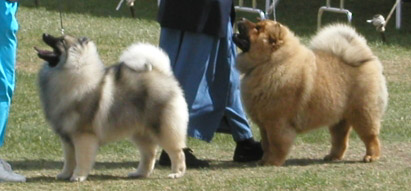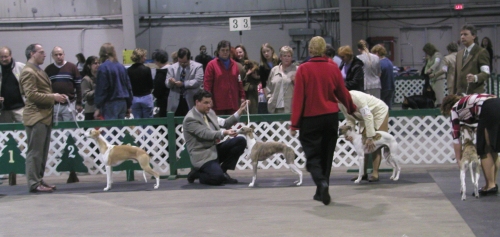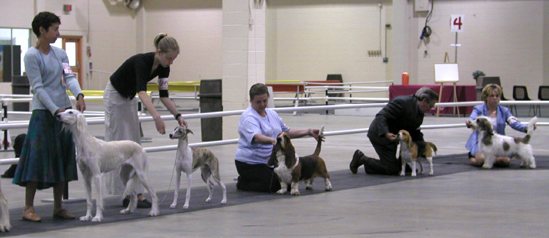Newsletter & Links
July's Newsletter
Sorry to have had no newsletters for such a long time... From now on I hope to be able to update this page every month with something new! This months newsletter deals with conformation dog shows and what they're all about. Enjoy!!
--------------------------------------------------------------------------------------------------------------------------------------------
Dog Shows - What Are They???
By Alyssa Nordstrom
The first time you attend a dog show you tour around and are amazed by the numerous different types of dogs you encounter. Chances are you were also intrigued by what was happening in the judging rings. In the judging rings you get to see dogs being paraded up and down, individually and as a group and also being posed by the person at the end of their leash (the handler). There is also a judge who stands in the center of the ring and examines each dog individually and all of the dogs together as a group. Eventually the judge makes a decision on his or her winners and hands them each a ribbon as they leave the ring, and applause may come from the crowd as he chooses his winners. You may also wonder why the dog that you liked so much left the ring without a ribbon. Hopefully this will help you to understand why that dog that you adored didn't win.... When you understand what a dog show is all about and what's going on you are bound to get much more enjoyment out of the show.

Afghan Hound
The primary purpose of a dog show is to evaluate breeding stock and enable owners to exhibit their dogs in a competitions against others of the same breed. The whole process is to help improve the quality of purebred dogs. This is achieved by responsible breeders who are dedicated to improving the quality of their breed, and only using dogs which can contribute to this quality and are good representatives of their breed, with proper temperaments and have been tested for genetic problems.
Each recognized breed of dog has it's own breed standard and at a dog show each dog is judged against this breed standard. The judge tries to pick the dog that is closest to the standard, both physically and mentally.

Left: Keeshond Right: Chow Chow
Both members of Group 6 (Non-Sporting Group)
Each dog entered in a show must be registered (If you live in the U.S.A.
they must be registered with the American Kennel Club, and in Canada they
must be registered with the Canadian Kennel Club. If you live in a
country other than the US or Canada then your dog must be registered with
the all breed club in your country), intact and must be over 6 months of
age.
For each breed their are different classes that the dogs can be entered in at a show.
In the US these classes are: 6-9 Month Puppies, 9-12 Month Puppies, 12-18 Month Puppies, Open, American Bred, Bred-By-Exhibitor, & Specials Only.
The 6-9 Month Puppy Class is for puppies ages 6 months to 9 months.
The 9-12 Month Puppy Class is for puppies ages 9 months to 12 months
The 12-18 Month Class is for dogs 12 months to 18 months
The Open Class is for any dog over 6 months of age
American Bred Class is for any dog born in the US
Bred-By-Exhibitor class is for any dog that is owned by its breeder and is also being shown by its breeder.
The
Specials Only class is for any dog that has attained its American
Championship. These dogs do not compete for any more championship
points since they are already champions.
In Canada the classes are the same except for it's referred to as Canadian
Bred rather than American Bred (meaning only dogs born in Canada can be
shown in this class) and also there is usually no 12-18 month class.
Each breed is judged separately and males and females are also judged separately to start with, so really their is two of each of the above classes (one for males and the other for females) for each breed.
Each of these classes (excluding Specials Only) are judged separately and 1st place to 4th place are awarded for each of them. Each of the males that wins 1st place in their class then comes back into the ring for the judge to look at again. This time the judge is deciding on his Winners Male. He will choose one of the 1st place males for this award. The dog awarded Winners will receive a certain number of championship points (depending on the number of dogs he beats). After Winners is chosen then Reserve Winners will be chosen. For this the dog that placed 2nd to the Winners Male will be invited back in with all the other 1st place dogs to choose the Reserve Winners. Reserve Winners does not receive any points. After they have done this for the males then they will do the same for the females. Once Winners Female and Reserve Winners Female are chosen they will then go to compete for Best Of Breed. When judging Best Of Breed all the Specials Males and Specials Females will come into the ring as well as the Winners Male and Winners Female. Best Of Breed will be chosen from one of these dogs. Best of Winners will be the next award, and it will go to either the Winners Male or the Winners Female. Then the judge will choose a Best Of Opposite Sex. This will be the dog who, in the judges mind, is the Best Of Opposite Sex to the Best Of Breed winner. So if Best Of Breed went to a male then Best Of Opposite Sex would have to go to a female and vice versa. Winners Male, Winners Female, and all the Specials compete for Best of Breed as well as Best Of Opposite Sex. In Canada and some shows in the US a Best Puppy is also chosen. For this the judge will pick the puppy who he thinks is the best (this includes any dog under the age of 12 months. In Canada it can come from any class, including specials only, but in the US it has to come from a Puppy Class, either 6-9 month or 9-12 month).

Whippet Breed Judging
This is done for every breed entered at the show. Each breed in each of the Seven Groups will go through this process. All the breeds are split up into these groups based on their original purpose (ie. Hunting dogs are in the Sporting Group which is strictly for other Hunting dogs and Terriers are all in the Terrier group which is only for dogs that were used to hunt varmint and 'go to ground').
The seven groups are:
Group 1 - Sporting
Group 2 - Hound
Group 3 - Working
Group 4 - Terriers
Group 5 - Toys
Group 6 - Non-Sporting
Group 7 - Herding
Once all the breeds in a group
have been judged then Group Judging Begins. Here the judge brings in
all the Best Of Breed Winners from that group into the ring to compete for:
1st In Group, 2nd In Group, 3rd In Group and 4th In Group. In Canada
they also have an award called Best Puppy In Group (Where all the Best
Puppy In Breed Winners compete against each other for Puppy Group), and at
some shows in the US they also have Puppy Group 1st, 2nd, 3rd and 4th.

Part of the Hound Group Line Up (Saluki, Whippet, Basset Hound, Beagle, Petite Basset Griffon Vandeen)
At the end of the day is Best In Show, where all 7 of the Group 1st Winners come together for the judge to choose 1 Best In Show winner. Then after Best In Show is judged they will also bring back all the Puppy Group Winners to compete for Best Puppy In Show.
Hopefully this newsletter will provide with enough information to help you understand what's really going on at a dog show.
To View Past Newsletters Please Click Here
~*~IN MEMORIAM~*~
Rescue Links
If you would like your rescue link listed here please email me
American Whippet Club Rescue Contacts
Country Paws Rescue & Adoption Shelter
German Shepherd Dog Rescue Houston, Inc
Good Stuff (Lots Of Links To Dog Related Sites)
National Whippet Club Of Canada Rescue Contacts
| Home | Introduction | Art Gallery | Newsletter & Links | Contact Us |
ã Copyright 2002 Passionfruit Studio